Voice to Books: We Need Diverse Writing Workshops

Ask writers from a marginalized community about their workshop experiences, and far too many can reply with stories of being stereotyped, exoticized, infantilized, or disregarded—by fellow workshop participants and instructors alike—for being queer, non-white, female, gender-nonconforming, disabled, neurodivergent, etc.
Although more people have vocalized these concerns and requested more diverse creative writing faculties, budget cuts and hiring freezes sometimes hamper even the most well-intentioned attempts at equity and inclusion. But that means writing instructors must hold themselves accountable for creating more open-minded learning environments and take action. Claiming support for marginalized communities is not enough; true allyship involves making a conscious effort to include others.
This month’s Voice to Books is presented by three educators and two creative writing graduate students, highlighting books by people of color and queer writers who cover not only the reasons for teaching more inclusively, but also ways to lead workshops more compassionately. Hopefully, these will help educators identify their own blind spots as teachers and writers and inspire others to create and facilitate diverse writing workshops.
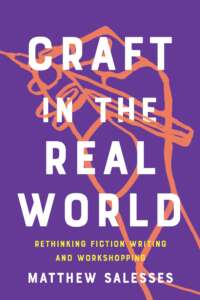
Craft in the Real World: Rethinking Fiction Writing and Workshopping
By Matthew Salesses
Reviewed by Eli Ryder
Aimed at college-level creative writing instructors, Craft in the Real World interrogates how we look at the practices of writing, teaching writing, and providing feedback. Salesses challenges existing paradigms by identifying the ways traditional workshops privilege the culture in which the workshop exists and often silence the author. The problem, Salesses asserts, is that craft trends rising from academic tradition ignore how the writer writes in and navigates the real world. This contextualization is as important a conversation in workshop spaces as the writing itself.
The book illustrates the history of Western ideas of craft as rising from practices generated by the particular tastes of old white men. Citing Eric Bennett’s work on post-World War II MFA programs, Salesses points out “the Iowa Writers’ Workshop, the first place to formalize the education of creative writing, fundraised on claims that it would spread American values of freedom.” That nationalistic pride perpetuated a decidedly Western aesthetic that traditional workshops privilege over other culturally significant storytelling traditions. Salesses’s example highlights a Korean writer whose fiction isn’t character-driven and whose meaning isn’t hidden or lurking beneath the surface, and yet is artistically successful despite “violating” Western tenets of craft.
Salesses offers a plethora of valuable workshop formats and revision exercises that expand the idea of audience, remove gag rules for writers, and otherwise include cultural context and authorial identity in discussions of creation and revision. An easy-to-implement example is what Salesses calls “a modified version of Critical Response Process,” in which authors submit workshop material accompanied by notes describing their process, intended audience, and craft decisions made during drafting and revisions. This allows workshop content to focus on authorial intent, rather than assuming Western craft sensibilities and critical perspective.
Programs and teachers that celebrate difference, practice asset-based andragogy, and fully accept the responsibility of anti-racist practices as foundational to teaching would benefit from this book’s practical approach to diverse and inclusive teaching of real-world craft. Those programs and teachers who don’t? They need this book even more.
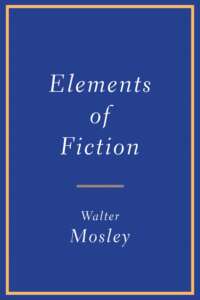
Elements of Fiction
By Walter Mosley
Reviewed by Timothy Chambers
Walter Mosley’s Elements of Fiction follows his first instructional book This Year You Write Your Novel. Where This Year is a left-brain class on craft, Elements is a right-brain, trust-your-gut companion volume. Mosley is the knowing grandpa cajoling storytellers from all walks of life with the notion that if one can talk a story, one can write one. Elements is the bold but necessary step from craft to heart, from concept to page. It is ideal for writers’ workshops to facilitate the jump from task-oriented production to employing the subconscious, where Mosley believes a writer’s true genius lies.
Mosley suggests readers approach the blank page as an invitation to explore rather than an obstacle to overcome. Rather than a textbook approach of how, Mosley takes a let’s walk through this one together approach. He starts with a prompt, then considers how and where potential solutions would direct the story. This approach shows the reader the pulsing cursor need not be an accuser, but instead an inviting partner on the writing journey. Mosley’s own solutions to his prompts exemplify how adding characters and various plots lead to exciting surprises.
Elements encourages readers to dig within for a good story. Craft is important, but too often it inhibits the creative ideas beneath the conscious, whirling, oft-overwhelmed mind. While Mosley acknowledges some writers prefer outlines and character biographies in order to know who and what they’re writing about, Mosley challenges readers to be in discovery mode, meeting their characters as the story unfolds.
Elements offers a remedy for writer’s block by opening the idea vault, encouraging readers to put aside their own or others’ expectations. Mosley shows that experimentation is not an invitation to failure, but rather opens doors of possibility and freedom. At only ninety pages, Elements is a confidence-boosting, get-up-and-go handbook to help writers approach writing with enthusiasm. Mosley has shown that much treasure awaits when we dig beneath the established rules and the surface.
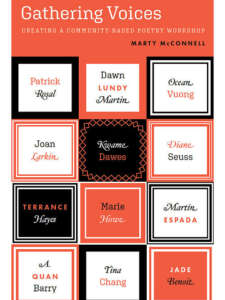
Gathering Voices: Creating a Community-Based Poetry Workshop
By Marty McConnell
Reviewed by Dorothy Rice
Gathering Voices is a how-to manual for convening a community-based poetry workshop. Included are a description of the philosophy and method, logistical details for a successful workshop, and twenty-four full workshop plans, each including a sample poem, discussion questions and a writing exercise.
Among the basic premises of the “Gathering Voices” approach are that sessions are held on a donation-only basis, all levels of experience and education are welcome, and poems are workshopped not as “broken things in need of fixing,” but as art with possibilities that participants get to unpack. The selected poems—work from current authors representing a range of genders, racial and ethnic backgrounds, and aspects of queerness—are the book’s strength. Particularly for a “community-based” workshop, poems that mirror the diversity in the room—and that push other participants to consider these issues—are more likely to generate connections, reflection, analysis and brave new writing.
McConnell’s discussion questions allow participants to determine how vulnerable they want to be about sensitive topics. For example, in Ocean Vuong’s “Because It’s Summer,” the young narrator has lied to their mother about the gender of the person they are meeting. The guiding question for group discussion (“What is one lie you have told someone who has raised you?”) is accompanied with the instruction that this can be a tiny lie or something much more significant, encouraging trust (or not) as the group jells. With this, McConnell shows that the role of the workshop leader is to establish and maintain a safe and trusting writing space as each poet explores how deep to go.
Some teachers may find the exercises overly complex. For example, the exercise accompanying “Because It’s Summer” involves five steps before the writing begins, followed by a worksheet with a series of instructions for the “free write.” If only for the poems alone, Gathering Voices is worthwhile. The questions and prompts will inspire generative writing, not only for poets but for prose writers, too, particularly in personal writing, such as memoir.
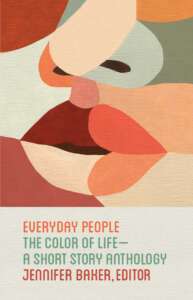
Everyday People: The Color of Life—A Short Story Anthology
Edited by Jennifer Baker
Reviewed by Yennie Cheung
As a teaching tool, story anthologies are often invaluable textbooks for demonstrating craft elements in action, but many popular collections contain the same classic tales from canonized writers with little diversity. Everyday People moves in the right direction with a collection of well-crafted stories by contemporary writers of color like Yiyun Li, Jason Reynolds, and Brandon Taylor.
Craft-wise, the anthology provides plenty to analyze. Mitchell S. Jackson’s “High Pursuit” mixes a poet’s meticulous wordsmithing with street slang to reveal character, such as a pimp’s Cadillac that is, according to the protagonist, “heaven white, with flesh-colored guts” and “the kind of ride that hurts my feelings to look at.” Meanwhile, Alexander Chee’s understated “Mine” shines as a gay, Korean-American, coming-of-age alternative to Raymond Carver’s oft-taught “Cathedral,” exploring similar ideas of emotional distance that build to an unexpected and touching end.
One important aspect of the anthology is that the stories usually depict the characters’ cultures as conventional rather than exotic. This includes Li’s “A Sheltered Woman,” in which a childless older woman tends to a new mother practicing the Chinese tradition of “sitting the month” after giving birth. Li’s details, from character names to arrogant attitudes, accurately capture the lives and personalities of contemporary Chinese and Chinese Americans without providing cultural explanations for non-Chinese readers. Similarly, “If a Bird Can Be a Ghost” by Allison Mills depicts a Native American family that talks to ghosts and explains rituals only when teaching the child protagonist, then teases Westerners for cultural appropriation.
In normalizing these characters’ perspectives rather than othering them, Everyday People shows experiences that are, as the title suggests, commonplace, accessible, and inherently human. Teaching the pieces as such in classrooms should encourage students to analyze stories from the characters’ point of view, not just their own.
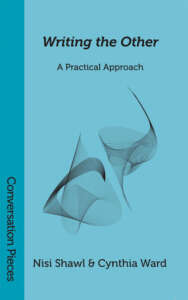
Writing the Other: A Practical Approach
By Nisi Shawl and Cynthia Ward
Reviewed by Karen A. Parker
Before the rise of cancel culture, writers canceled themselves. In 1992, one student in Nisi Shawl and Cynthia Ward’s Clarion West Writers Workshop was paralyzed with fear. They feared writing about people with perspectives different from their own because they assumed they’d get it wrong and appear racist.
First published in 2005, Writing the Other: A Practical Approach remains a classic, introductory text for those who want to portray characters that exist outside the dominant “white, male, heterosexual, single, young, and physically able” paradigm. For example, one writing exercise and its follow-up questions involves roleplaying a conversation between partners with randomly chosen character traits, such as a Buddhist who bites their nails and an Afro-Caribbean professional manicurist. In doing so, Shawl and Ward provide a safe space for writers to explore their unconscious biases while simultaneously strengthening their empathic writing muscles.
Shawl and Ward show us that writing the other is the very thing that writers can and should do precisely because, as they say, “we are writers.” We can and should write the other in order to respectfully depict cultures and lives that are not our own. We must challenge the very idea of a dominant cultural paradigm in the name of creating a more diverse, equitable, and inclusive world.
Eighteen years later, we’ve seen significant shifts in conversations about writing the other. We champion #OwnVoices and hire sensitivity readers. However, there’s still work to be done on the part of the writer so that they don’t self-sabotage through censorship or reaching for an easy stereotype.
Writing the Other broke new ground in terms of writing guides of its kind. Today, it can still help writers write their best stories so long as they have the courage and curiosity to try.
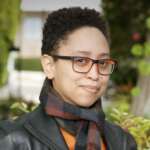
Voice to Books is a periodical short list of reviews from a variety of voices, created by Daniela Z. Montes and A.E. Santana and edited by Karen A. Parker.
Karen A. Parker is a Black, bi, nonbinary Secular Buddhist from Los Angeles, California. Now attending UC Riverside-Palm Desert’s MFA program, they hope to research Esoteric Buddhism, oral storytelling tradition, and Black liberation for their debut second-world fantasy novel, which will serve as their literary and academic thesis. When they’re not writing, they enjoy cooking, cartomancy, composing music, critting in Dungeons & Dragons, and completing their video game collection.
